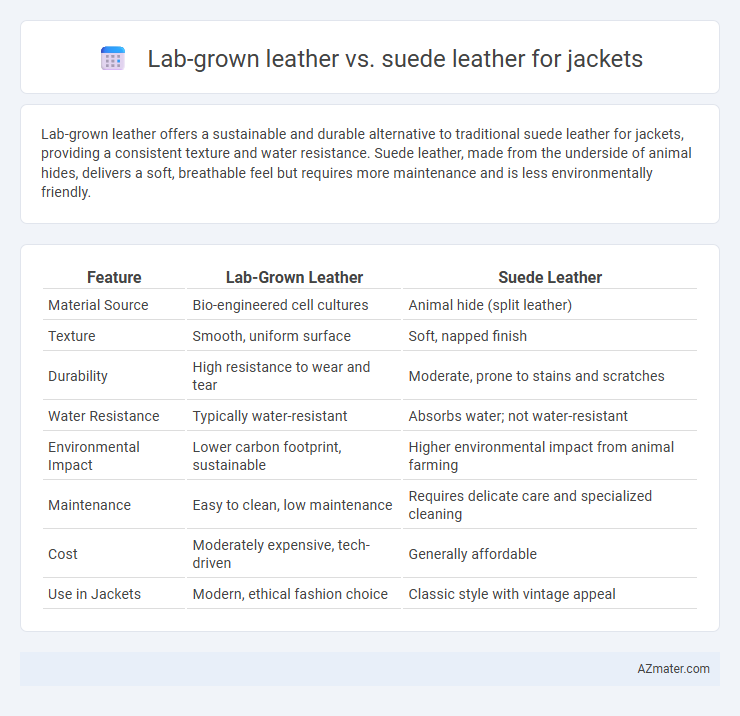Lab-grown leather offers a sustainable and durable alternative to traditional suede leather for jackets, providing a consistent texture and water resistance. Suede leather, made from the underside of animal hides, delivers a soft, breathable feel but requires more maintenance and is less environmentally friendly.
Table of Comparison
| Feature | Lab-Grown Leather | Suede Leather |
|---|---|---|
| Material Source | Bio-engineered cell cultures | Animal hide (split leather) |
| Texture | Smooth, uniform surface | Soft, napped finish |
| Durability | High resistance to wear and tear | Moderate, prone to stains and scratches |
| Water Resistance | Typically water-resistant | Absorbs water; not water-resistant |
| Environmental Impact | Lower carbon footprint, sustainable | Higher environmental impact from animal farming |
| Maintenance | Easy to clean, low maintenance | Requires delicate care and specialized cleaning |
| Cost | Moderately expensive, tech-driven | Generally affordable |
| Use in Jackets | Modern, ethical fashion choice | Classic style with vintage appeal |
Overview of Lab-Grown Leather and Suede Leather
Lab-grown leather is engineered using bio-fabrication techniques that replicate animal leather without harming animals, offering sustainable and eco-friendly alternatives with customizable properties. Suede leather is derived from the underside of animal hides, characterized by a soft, napped finish that provides a luxurious texture but requires delicate care to maintain durability. Jackets made from lab-grown leather combine innovation and environmental responsibility, while suede jackets emphasize traditional craftsmanship and distinct tactile appeal.
Production Processes: Lab-Grown vs Suede Leather
Lab-grown leather is produced through a bio-fabrication process, cultivating collagen proteins in a lab environment to mimic natural leather without animal hides, significantly reducing environmental impact and resource consumption. Suede leather, on the other hand, is derived from the inner split of animal hides, requiring extensive tanning and finishing processes that involve chemicals and water usage, impacting sustainability. Lab-grown leather offers a more controlled, scalable production method with consistent quality, while suede leather relies on traditional craftsmanship and animal sourcing, affecting availability and ethical considerations.
Sustainability and Environmental Impact
Lab-grown leather significantly reduces environmental impact by eliminating the need for animal farming, which lowers greenhouse gas emissions, water usage, and land degradation compared to suede leather derived from animal hides. Traditional suede leather involves chemical-intensive tanning processes that contribute to water pollution and toxic waste, whereas lab-grown leather employs more sustainable, biofabrication techniques with minimal harmful byproducts. Choosing lab-grown leather jackets promotes a more sustainable fashion industry by conserving natural resources and reducing ecological footprints associated with conventional suede production.
Durability and Longevity Comparison
Lab-grown leather offers enhanced durability and resistance to wear compared to traditional suede leather, making it a superior choice for jackets that require long-lasting material. Suede leather, while prized for its softness and aesthetic appeal, tends to be less durable due to its napped surface, which is more susceptible to scratches and stains. The non-porous and engineered structure of lab-grown leather contributes to greater longevity, maintaining its shape and appearance over extended use.
Texture, Feel, and Aesthetic Differences
Lab-grown leather offers a smooth, uniform texture with a consistent finish, mimicking traditional leather's natural grain, while suede leather features a soft, napped surface characterized by its fuzzy and velvety feel. The tactile sensation of lab-grown leather is typically firmer and less porous compared to the plush, breathable softness of suede, which enhances comfort and flexibility. Aesthetically, lab-grown leather presents a sleek, polished look with vibrant color retention, whereas suede provides a matte, rustic appeal that develops a unique patina over time, contributing to a more casual and rugged jacket style.
Performance in Various Weather Conditions
Lab-grown leather offers superior water resistance and durability compared to suede leather, making it ideal for wet or humid climates. Suede leather, while breathable and soft, tends to absorb moisture easily, which can lead to staining and reduced longevity in rainy or snowy weather. In extreme heat, lab-grown leather maintains its structure better, whereas suede may become stiff or cracked due to its open fiber texture.
Ethical Considerations and Animal Impact
Lab-grown leather offers a sustainable alternative to traditional suede leather by eliminating the need for animal farming and slaughter, significantly reducing animal cruelty and habitat destruction. Suede leather production involves raising and skinning animals, contributing to ethical concerns related to animal welfare and environmental degradation due to livestock farming. Choosing lab-grown leather supports a cruelty-free fashion industry while minimizing the carbon footprint and resource consumption associated with conventional suede leather jackets.
Price and Market Availability
Lab-grown leather generally commands a higher price point compared to suede leather due to advanced bio-fabrication technology and limited production scale, impacting its market availability. Suede leather, derived from animal hides, remains widely accessible and more affordable with established supply chains and mature manufacturing processes. Consumers seeking eco-friendly options face limited distributors for lab-grown leather jackets, while suede jackets dominate mainstream fashion retail with broader availability and lower costs.
Maintenance and Care Requirements
Lab-grown leather requires minimal maintenance with easy cleaning using mild soap and water, offering durability and resistance to cracking or peeling. Suede leather demands more delicate care, needing specialized brushes and conditioners to maintain its texture while being prone to stains and water damage. Choosing lab-grown leather ensures a low-maintenance option ideal for daily wear, whereas suede requires vigilant upkeep to preserve its soft, matte finish.
Which Leather is Best for Jackets?
Lab-grown leather offers a sustainable and cruelty-free alternative to traditional suede leather, featuring enhanced durability and water resistance ideal for jackets. Suede leather provides a soft, textured finish with a classic aesthetic but requires more maintenance and is prone to staining and water damage. Choosing the best leather for jackets depends on prioritizing eco-friendliness and longevity with lab-grown leather or opting for the luxurious feel and vintage style of suede.

Infographic: Lab-grown leather vs Suede leather for Jacket
 azmater.com
azmater.com